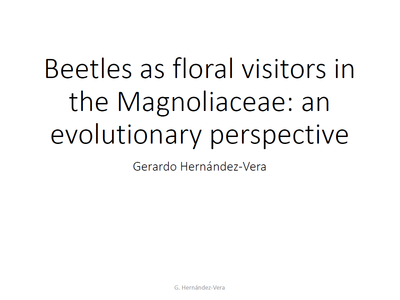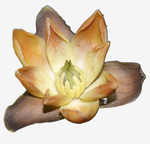Beetles as floral visitors in the Magnoliaceae: an evolutionary perspective
GERARDO HERNÁNDEZ-VERA1, JOSÉ LUIS NAVARRETE-HEREDIA2 & JOSÉ ANTONIO VÁZQUEZ-GARCÍA1
- Instituto de Botánica, Departamento de Botánica y Zoología, Centro Universitario de Ciencias Biológicas y Agropecuarias, Universidad de Guadalajara, Camino Ramón Padilla Sánchez 2100 Nextipac, Zapopan, Jalisco, México.
- Departamento de Botánica y Zoología, Centro Universitario de Ciencias Biológicas y Agropecuarias, Universidad de Guadalajara, Camino Ramón Padilla Sánchez 2100 Nextipac, Zapopan, Jalisco, México.
With approximately 400,000 described species, beetles (Coleoptera) are the most diverse group of insects, accounting for 40% of the total insect diversity and approximately 25% of all known animal life-forms. Due to its ancient origin in the Permian and the high proportion of beetle-pollinated taxa within basal magnoliid lineages, it has been hypothesized that beetles were among the first floral visitors of the proto-angiosperms on Earth. Thus, beetle-pollinated flowers have become important model systems essential for the study of the origin and evolution of angiosperms. Under an evolutionary perspective, we review what is currently known about beetles as floral visitors in the family Magnoliaceae, one of the earliest extant groups of flowering plants. Nitidulidae and Scarabaeidae are the two most common groups of beetles reported in the literature as floral visitors to Magnoliaceae, however, the evidence indicates that most modern families of beetles including all the families with known taxa associated with Magnoliaceae had already originated when the latter first appeared by the end of the early Cretaceous. Since evidence from fossils indicates that some groups of beetles transitioned from gymnosperms to angiosperms as host plants, Magnoliaceae could have represented a newly opened ecological niche that beetles gradually colonized and exploited, possibly shifting from gymnosperm hosts. By feeding, mating and sheltering in their flower structures, beetles have played a major role in shaping the floral biology and morphology of Magnoliaceae. Further studies should assess the possible role of anthophagous scarabs (subfamilies Cetoniinae, Melolonthinae, Dynastinae and Rutelinae) in the diversification of Magnoliaceae, since this event broadly coincides with the origin of those groups of beetles, some of which exhibit very close associations with several Magnoliaceae species.

